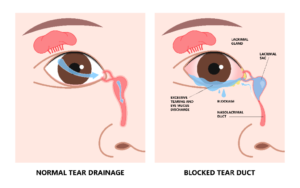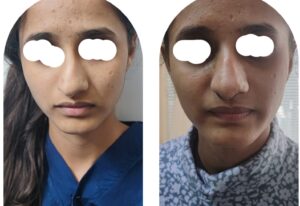1)Endoscopic Nasal Surgery
2)Endoscopic DCR
3)Rhinoplasty
Endoscopic Nasal Surgery
There are many diseases related to nose and can be treated medically. But sometimes Patient may need surgery
Endoscopic nose surgeries are versatile procedures that can effectively treat various nasal conditions. Some of the diseases and conditions that can be treated with endoscopic nose surgeries include:
Chronic Sinusitis: Functional Endoscopic sinus surgery (FESS)is commonly performed to treat chronic sinusitis, which is a persistent inflammation of the sinuses that causes facial pain, headache, nose block, nasal discharge.
Nasal Polyps: Nasal polyps are noncancerous growths that develop in the lining of the nasal passages or sinuses. Endoscopic surgery can remove polyps along with powered instruments.
Deviated Septum: A deviated septum occurs when the thin wall (nasal septum) between the nostrils is off-center, leading to breathing difficulties and nasal blockages. Endoscopic septoplasty can straighten the septum, improving airflow and reducing symptoms.
Nasal Obstructions: Endoscopic nasal surgeries can address various obstructions in the nasal passages, such as scar tissue, enlarged turbinates, or foreign bodies, which can cause breathing problems.
Sinus Cysts and Tumors: Endoscopic surgery allows for the safe removal of sinus cysts or certain nasal tumors, aiding in improved breathing and reducing the risk of complications.
Recurrent Epistaxis (Nosebleeds): For patients with frequent or severe nosebleeds caused by blood vessel abnormalities, endoscopic nasal surgery can be used to cauterize or repair the affected vessels.
It is important to note that the specific approach and procedure may vary depending on the individual’s condition and the ENT specialist’s evaluation. Endoscopic nose surgeries are typically safe and have a faster recovery time compared to traditional open procedures, making them a preferred choice for many patients with nasal conditions. However, it is crucial to consult with a qualified ENT specialist to determine the most appropriate treatment plan for each case.

An endoscopic DCR (dacryocystorhinostomy) is a surgical procedure performed by an ENT (ear, nose, and throat) doctor to treat a blockage in the tear drainage system. This blockage often leads to chronic tearing and recurrent infections in the eyes.
During the endoscopic DCR procedure, the ENT doctor uses an endoscope, which is a thin, flexible tube with a camera, to access the tear drainage system through the nasal cavity. The goal of the surgery is to create a new opening between the blocked tear sac and the nasal cavity, allowing tears to bypass the obstruction and drain properly.
Compared to traditional DCR surgery, which involves making an external incision on the skin, endoscopic DCR is considered less invasive, resulting in less scarring and a quicker recovery time.
The ENT doctor will carefully evaluate the patient’s condition and medical history to determine if an endoscopic DCR is the appropriate treatment option. It is essential to follow the doctor’s pre-operative and post-operative instructions to ensure a successful outcome and reduce the risk of complications.
If you are experiencing persistent tearing or other eye-related issues, it is best to consult an ENT doctor who can assess your specific situation and recommend the most suitable treatment for you.
Rhinoplasty

Rhinoplasty is a surgical procedure that involves reshaping and reconstructing the nose to improve its appearance and native function such as breathing difficulties. While rhinoplasty is commonly associated with plastic surgeons, it can also be performed by an ENT (ear, nose, and throat) surgeon who has specialized training and expertise in nasal anatomy and function.
They are well-qualified to perform rhinoplasty procedures, especially when the surgery involves correcting nasal obstructions or addressing issues related to the nasal airway.
ENT specialist can perform various techniques, such as open rhinoplasty (where a small external incision is made) or closed rhinoplasty (where incisions are made inside the nostrils), depending on the specific goals and needs of the patient.
